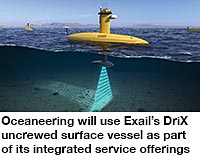Oceaneering introduces uncrewed surface vessel service to support remote survey scopes
02/10/2023
Oceaneering International has announced that its Subsea Robotics group is introducing a new uncrewed surface vessel (USV) service to support remote survey work scopes.
Exail and Oceaneering have reached an agreement where Oceaneering will purchase its first DriX uncrewed surface vessel to support deepwater geophysical and asset inspection operations, including autonomous underwater vehicle (AUV) positioning and offshore and nearshore surveys. The use of the DriX uncrewed surface vessel on offshore survey and inspection work scopes will enable Oceaneering to improve operational efficiencies, reduce overall vessel time on site and significantly reduce carbon emissions.
Oceaneering’s uncrewed surface vessel service offering will utilise dual independent positioning correction services from Oceaneering’s C-NAV group for uninterrupted operations, thereby improving reliability. Oceaneering’s service will be the only uncrewed surface vessel equipped with true dual redundancy for guaranteed continuity of service, it is claimed.
Eric Smith, Senior Director of Survey Services at Oceaneering, said: “It is the natural progression of our extensive experience with remote operations that we combine uncrewed surface vessels with Oceaneering’s existing remotely operated underwater vehicle (ROV) and autonomous underwater vehicle fleets and onshore remote operations centres to deliver significant opportunities to scale operations and drive greater efficiencies. The service will directly support the market growth of IMRGE, our integrated and customisable inspection, maintenance and repair (IMR) strategy.”
Martin McDonald, Senior Vice President of Subsea Robotics, said: “We are excited to use the DriX uncrewed surface vessel as part of our integrated service offerings and to pair it with our autonomous underwater vehicle systems, such as the Freedom vehicle. The DriX allows us to remotely gather the same high-quality data at a lower operational impact, without the need for an offshore-based crew. This reduces health, safety and environmental risks while freeing up multi-service vessels to complete other tasks.”
Olivier Cervantes, Vice President of Maritime Autonomy at Exail, said: “Oceaneering and Exail have a long-term partnership. It is a great pleasure to collaborate now on expanding subsea exploration due to automated systems such as DriX and Freedom. This collaboration opens new capabilities in the subsea construction, inspection and survey domains.”
The DriX uncrewed surface vessel has accumulated several thousands of hours in operation since entering service in 2016 and is able to conduct over-the-horizon supervised autonomous operations thanks to its artificial intelligence-powered CortiX software and state-of-the-art sensors.
The uncrewed surface vessel’s shape and stability allows for continued operations alongside Oceaneering’s autonomous underwater vehicles in poor sea conditions found offshore (up to sea state 5), without compromising data quality.
The uncrewed surface vessel’s speed and endurance also reduces transit downtime and enables high-speed nearshore surveys to be conducted, obtaining optimal data quality that is harvested in a fraction of the usual times. It offers a lower environmental footprint at only two litres of fuel usage per hour, when compared with a crewed vessel, thereby reducing carbon emissions.
Oceaneering is a leader in remote operations, having established its first dedicated onshore remote operations facility in 2015 in Stavanger, Norway, and has achieved over 100,000 hours of piloting from shore. In addition to this, Oceaneering has pioneered remotely operated survey since 2016, helping to transition over 9000 personnel days from the field.
